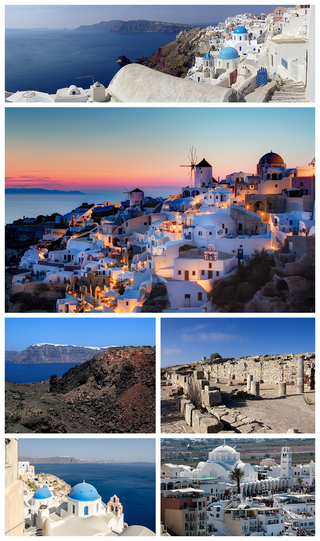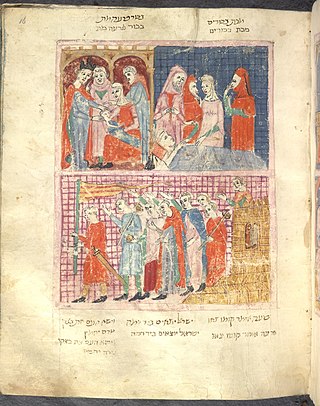The Book of Exodus is the second book of the Bible. It is a narrative of the Exodus, the origin myth of the Israelites leaving slavery in Biblical Egypt through the strength of their deity named Yahweh, who according to the story chose them as his people. The Israelites then journey with the legendary prophet Moses to Mount Sinai, where Yahweh gives the Ten Commandments and they enter into a covenant with Yahweh, who promises to make them a "holy nation, and a kingdom of priests" on condition of their faithfulness. He gives them their laws and instructions to build the Tabernacle, the means by which he will come from heaven and dwell with them and lead them in a holy war to conquer Canaan, which has earlier, according to the myth of Genesis, been promised to the "seed" of Abraham, the legendary patriarch of the Israelites.

Santorini, officially Thira and Classical Greek Thera, is a Greek island in the southern Aegean Sea, about 200 km (120 mi) southeast from its mainland. It is the largest island of a small, circular archipelago formed by the Santorini caldera. It is the southernmost member of the Cyclades group of islands, with an area of approximately 73 km2 (28 sq mi) and a 2021 census population of 15,480. The municipality of Santorini includes the inhabited islands of Santorini and Therasia, as well as the uninhabited islands of Nea Kameni, Palaia Kameni, Aspronisi and Christiana. The total land area is 90.623 km2 (34.990 sq mi). Santorini is part of the Thira regional unit.

The Crossing of the Red Sea or Parting of the Red Sea is an episode in the origin myth of The Exodus in the Hebrew Bible.

Ahmose I was a pharaoh and founder of the Eighteenth Dynasty of Egypt in the New Kingdom of Egypt, the era in which ancient Egypt achieved the peak of its power. His reign is usually dated to the mid-16th century BC at the beginning of the Late Bronze Age.
Tempest is a synonym for a storm.

The Plagues of Egypt, in the account of the Book of Exodus, are ten disasters inflicted on biblical Egypt by the God of Israel (Yahweh) in order to convince the Pharaoh to emancipate the enslaved Israelites, each of them confronting Pharaoh and one of his Egyptian gods; they serve as "signs and marvels" given by God to answer Pharaoh's taunt that he does not know Yahweh: "The Egyptians shall know that I am the LORD". The Ten Plagues are recited during the Passover Seder.

The Sothic cycle or Canicular period is a period of 1,461 Egyptian civil years of 365 days each or 1,460 Julian years averaging 365+1⁄4 days each. During a Sothic cycle, the 365-day year loses enough time that the start of its year once again coincides with the heliacal rising of the star Sirius on 19 July in the Julian calendar. It is an important aspect of Egyptology, particularly with regard to reconstructions of the Egyptian calendar and its history. Astronomical records of this displacement may have been responsible for the later establishment of the more accurate Julian and Alexandrian calendars.

The Exodus is the founding myth of the Israelites whose narrative is spread over four of the five books of the Pentateuch.

The majority of Egyptologists agree on the outline and many details of the chronology of Ancient Egypt. This scholarly consensus is known as the Conventional Egyptian chronology, which places the beginning of the Old Kingdom in the 27th century BC, the beginning of the Middle Kingdom in the 21st century BC and the beginning of the New Kingdom in the mid-16th century BC.

Va'eira, Va'era, or Vaera is the fourteenth weekly Torah portion in the annual Jewish cycle of Torah reading and the second in the Book of Exodus. It constitutes Exodus 6:2–9:35. The parashah tells of the first seven Plagues of Egypt.

The Minoan eruption was a catastrophic volcanic eruption that devastated the Aegean island of Thera circa 1600 BCE. It destroyed the Minoan settlement at Akrotiri, as well as communities and agricultural areas on nearby islands and the coast of Crete with subsequent earthquakes and paleotsunamis. With a Volcanic Explosivity Index (VEI) of between 6 and 7, it resulted in the ejection of approximately 28–41 km3 (6.7–9.8 cu mi) of dense-rock equivalent (DRE), the eruption was one of the largest volcanic events in human history. Since tephra from the Minoan eruption serves as a marker horizon in nearly all archaeological sites in the Eastern Mediterranean, its precise date is of high importance and has been fiercely debated among archaeologists and volcanologists for decades, without coming to a definite conclusion.

Simcha Jacobovici is a Canadian-Israeli journalist, documentary filmmaker and pseudoarcheologist.
Hashem El Tarif is a mountain on the Sinai Peninsula, now in northeastern Egypt. It is one of several candidates for the biblical Mount Sinai, where the Abrahamic prophet Moses received the Ten Commandments. It stands 881 meters tall.
The Tempest Stele was erected by pharaoh Ahmose I early in the 18th Dynasty of Egypt, c. 1550 BCE. The stele describes a great storm striking Egypt during this time, destroying tombs, temples and pyramids in the Theban region and the work of restoration ordered by the king.

Minoan chronology is a framework of dates used to divide the history of the Minoan civilization. Two systems of relative chronology are used for the Minoans. One is based on sequences of pottery styles, while the other is based on the architectural phases of the Minoan palaces. These systems are often used alongside one another.

The Lost Tomb of Jesus is a pseudoarchaeological docudrama co-produced and first broadcast on the Discovery Channel and Vision TV in Canada on March 4, 2007, covering the discovery of the Talpiot Tomb. It was directed by Canadian documentary and film maker Simcha Jacobovici and produced by Felix Golubev and Ric Esther Bienstock, while James Cameron served as executive producer. The film was released in conjunction with a book about the same subject, The Jesus Family Tomb, issued in late February 2007 and co-authored by Jacobovici and Charles R. Pellegrino. The documentary and the book's claims have been rejected by the overwhelming majority of leading experts within the archaeological and theological fields, as well as among linguistic and biblical scholars.

Akrotiri is the site of a Cycladic Bronze Age settlement on the volcanic Greek island of Santorini (Thera). The name comes from the nearby village of Akrotiri.
The Parting of the Sea: How Volcanoes, Earthquakes, and Plagues Shaped the Exodus Story is a book written by Barbara J. Sivertsen in 2009.

The Bible makes reference to various pharaohs of Egypt. These include unnamed pharaohs in events described in the Torah, as well as several later named pharaohs, some of whom were historical or can be identified with historical pharaohs.
The Exodus is the founding myth of the Israelites. The scholarly consensus is that the Exodus, as described in the Torah, is not historical, even though there may be a historical core behind the Biblical narrative.














